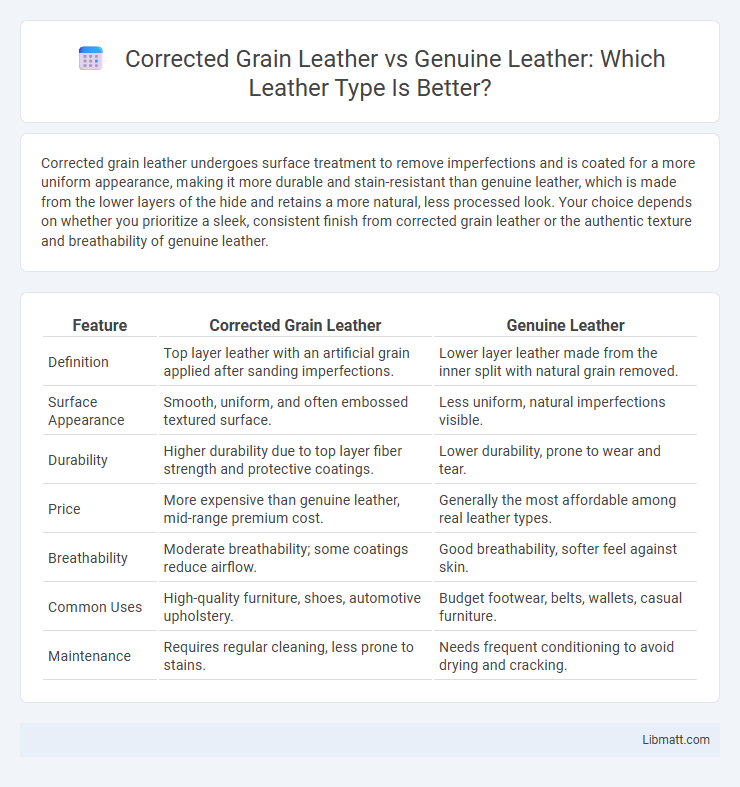Corrected grain leather undergoes surface treatment to remove imperfections and is coated for a more uniform appearance, making it more durable and stain-resistant than genuine leather, which is made from the lower layers of the hide and retains a more natural, less processed look. Your choice depends on whether you prioritize a sleek, consistent finish from corrected grain leather or the authentic texture and breathability of genuine leather.
Table of Comparison
| Feature | Corrected Grain Leather | Genuine Leather |
|---|---|---|
| Definition | Top layer leather with an artificial grain applied after sanding imperfections. | Lower layer leather made from the inner split with natural grain removed. |
| Surface Appearance | Smooth, uniform, and often embossed textured surface. | Less uniform, natural imperfections visible. |
| Durability | Higher durability due to top layer fiber strength and protective coatings. | Lower durability, prone to wear and tear. |
| Price | More expensive than genuine leather, mid-range premium cost. | Generally the most affordable among real leather types. |
| Breathability | Moderate breathability; some coatings reduce airflow. | Good breathability, softer feel against skin. |
| Common Uses | High-quality furniture, shoes, automotive upholstery. | Budget footwear, belts, wallets, casual furniture. |
| Maintenance | Requires regular cleaning, less prone to stains. | Needs frequent conditioning to avoid drying and cracking. |
Understanding Corrected Grain Leather
Corrected grain leather undergoes a surface treatment to remove natural imperfections, replacing the top grain with an artificial coating, which enhances durability and uniform appearance but may reduce breathability. Genuine leather, derived from the lower layers of the hide, offers natural texture and breathability but tends to be less resistant to wear and stains. Understanding corrected grain leather helps you choose materials that balance aesthetic appeal with practical longevity for your leather goods.
What Is Genuine Leather?
Genuine leather refers to a type of leather made from the lower layers of animal hide, often processed and treated to achieve durability and a consistent appearance. It is typically more affordable than top-grain or full-grain leather but lacks the natural texture and strength found in higher-quality leather types. Corrected grain leather is a subset of genuine leather that undergoes extensive sanding and coating to remove imperfections, resulting in a smooth, uniform surface.
Manufacturing Processes Compared
Corrected grain leather undergoes extensive sanding, buffing, and coating to conceal surface imperfections, making it more uniform in appearance than genuine leather, which retains its natural grain and texture. Genuine leather is produced by tanning and finishing rawhide with minimal surface alteration, preserving its original durability and breathability. Your choice depends on whether you prefer the consistent finish of corrected grain or the authentic character of genuine leather.
Surface Appearance and Texture
Corrected grain leather features a reworked surface where imperfections are sanded away and an artificial grain pattern is embossed, resulting in a uniform and smooth texture that can look less natural than genuine leather. Genuine leather retains the original grain, displaying unique marks and textures that give it a more authentic, breathable, and supple appearance. When choosing leather for your products, consider that genuine leather offers a rich, varied texture while corrected grain provides a consistent but artificial look.
Durability and Longevity
Corrected grain leather undergoes extensive sanding and finishing, making it less durable and prone to wear over time compared to genuine leather, which retains its natural grain and strength. Genuine leather's durability ensures greater longevity, resisting cracking and stretching, while corrected grain leather may require more maintenance to preserve its appearance. Choosing genuine leather enhances your investment by providing superior resilience and lasting quality.
Cost Differences Explained
Corrected grain leather typically costs more than genuine leather due to the additional processing involved in sanding, buffing, and applying surface coatings to improve appearance and durability. Genuine leather is more affordable as it retains its natural grain with minimal treatment, resulting in a less uniform but authentic texture. The price difference reflects the enhanced finish and longer lifespan of corrected grain leather compared to the more basic, raw characteristics of genuine leather.
Common Uses and Applications
Corrected grain leather is commonly used in furniture upholstery, automotive interiors, and fashion accessories where durability and a uniform appearance are important. Genuine leather, derived from the lower layers of the hide, is often found in products like wallets, belts, and casual footwear that emphasize affordability and natural texture. Understanding these material differences helps you choose the right leather for your specific application, balancing cost and aesthetic preferences.
Maintenance and Care Requirements
Corrected grain leather requires regular conditioning and cleaning to maintain its thin protective topcoat, which can wear off over time and expose the underlying fiber. Genuine leather, often aniline or semi-aniline, needs gentle cleaning with leather-specific products and periodic moisturizing to prevent drying and cracking while preserving its natural look. Both types benefit from avoiding excessive moisture and direct sunlight to extend durability and appearance.
Environmental Impact and Sustainability
Corrected grain leather undergoes extensive sanding and dyeing processes that contribute to higher chemical use and environmental pollution compared to genuine leather, which retains its natural surface with less processing. Genuine leather, sourced directly from animal hides with minimal alteration, generally offers better durability and longer product life, reducing waste over time. When choosing between the two, your preference for sustainable materials should consider the environmental costs of tanning, finishing, and potential for recycling in both leather types.
Which Leather Type Should You Choose?
Corrected grain leather undergoes surface treatments to mask imperfections, offering a more uniform appearance and increased durability, while genuine leather retains its natural texture but may show flaws and wear over time. Your choice depends on the desired balance between aesthetics and authenticity; corrected grain leather provides a polished look with enhanced resistance, whereas genuine leather offers a unique, natural character with potential for aging gracefully. Consider how you value longevity, maintenance, and the genuine feel when selecting between these two leather types.
Corrected grain leather vs genuine leather Infographic

 libmatt.com
libmatt.com